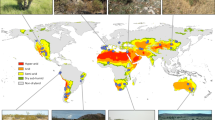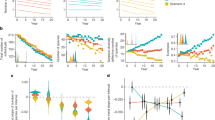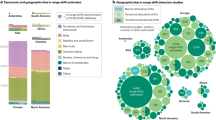Abstract
Many studies have shown that biodiversity regulates multiple ecological functions that are needed to maintain the productivity of a variety of ecosystem types. What is unknown is how human activities may alter the ‘multifunctionality’ of ecosystems through both direct impacts on ecosystems and indirect effects mediated by the loss of multifaceted biodiversity. Using an extensive database of 72 lakes spanning four large Neotropical wetlands in Brazil, we demonstrate that species richness and functional diversity across multiple larger (fish and macrophytes) and smaller (microcrustaceans, rotifers, protists and phytoplankton) groups of aquatic organisms are positively associated with ecosystem multifunctionality. Whereas the positive association between smaller organisms and multifunctionality broke down with increasing human pressure, this positive relationship was maintained for larger organisms despite the increase in human pressure. Human pressure impacted multifunctionality both directly and indirectly through reducing species richness and functional diversity of multiple organismal groups. These findings provide further empirical evidence about the importance of aquatic biodiversity for maintaining wetland multifunctionality. Despite the key role of biodiversity, human pressure reduces the diversity of multiple groups of aquatic organisms, eroding their positive impacts on a suite of ecological functions that sustain wetlands.
This is a preview of subscription content, access via your institution
Access options
Access Nature and 54 other Nature Portfolio journals
Get Nature+, our best-value online-access subscription
$29.99 / 30 days
cancel any time
Subscribe to this journal
Receive 12 digital issues and online access to articles
$119.00 per year
only $9.92 per issue
Buy this article
- Purchase on Springer Link
- Instant access to full article PDF
Prices may be subject to local taxes which are calculated during checkout






Similar content being viewed by others
Data availability
The data that support the findings of this study are publicly available on Zenodo Digital Repository at https://doi.org/10.5281/zenodo.6406782. Source data are provided with this paper.
Code availability
The code that supports the findings and figures of this study is available on Zenodo Digital Repository at https://doi.org/10.5281/zenodo.6406786.
References
Newbold, T. et al. Global effects of land use on local terrestrial biodiversity. Nature 520, 45–50 (2015).
Di Marco, M., Venter, O., Possingham, H. P. & Watson, J. E. M. Changes in human footprint drive changes in species extinctions risk. Nat. Commun. 9, 4621 (2018).
Cardinale, B. J. et al. Biodiversity loss and its impact on humanity. Nature 486, 59–67 (2012).
Hooper, D. U. et al. Effects of biodiversity on ecosystem functioning: a consensus of current knowledge. Ecol. Monogr. 75, 3–35 (2005).
Lefcheck, J. S. et al. Biodiversity enhances ecosystem multifunctionality across trophic levels and habitats. Nat. Commun. 6, 6936 (2015).
Soliveres, S. et al. Biodiversity at multiple trophic levels is needed for ecosystem multifunctionality. Nature 536, 456–459 (2016).
Schuldt, A. et al. Biodiversity across trophic levels drive multifunctionality in highly diverse forests. Nat. Commun. 9, 2989 (2018).
Delgado-Baquerizo, M. et al. Multiple elements of soil biodiversity drive ecosystem functions across biomes. Nat. Ecol. Evol. 4, 211–220 (2020).
Hooper, D. U. et al. A global synthesis reveals biodiversity loss as a major driver of ecosystem change. Nature 486, 105–108 (2012).
Allan, E. et al. Land use intensification alters ecosystem multifunctionality via loss of biodiversity and changes to functional composition. Ecol. Lett. 18, 834–843 (2015).
Jing, X. et al. The links between ecosystem multifunctionality and above- and belowground biodiversity are mediated by climate. Nat. Commun. 6, 8159 (2015).
Fanin, N. et al. Consistent effects of biodiversity loss on multifunctionality across contrasting ecosystems. Nat. Ecol. Evol. 2, 269–278 (2018).
Hautier, Y. et al. Local loss and spatial homogenization of plant diversity reduce ecosystem multifunctionality. Nat. Ecol. Evol. 2, 50–56 (2018).
Venter, O. et al. Global terrestrial human footprint maps for 1993 and 2009. Sci. Data 3, 160067 (2016).
Allan, E. et al. Interannual variation in land-use intensity enhances grassland multidiversity. Proc. Natl Acad. Sci. USA 111, 308–313 (2014).
Moi, D. A. et al. Regime shifts in a shallow lake over 12 years: consequences for taxonomic and functional diversities, and ecosystem multifunctionality. J. Anim. Ecol. 91, 551–565 (2022).
Moi, D. A. et al. Multitrophic richness enhances ecosystem multifunctionality of tropical shallow lakes. Funct. Ecol. 35, 942–954 (2021).
Byrnes, J. E. K. et al. Investigating the relationship between biodiversity and ecosystem multifunctionality: challenges and solutions. Methods Ecol. Evol. 5, 111–124 (2014).
Li, F. et al. Human activitiesʼ fingerprint on multitrophic biodiversity and ecosystem functions across a major river catchment in China. Glob. Change Biol. 26, 6867–6879 (2020).
Enquist, B. J. et al. The megabiota are disproportionately importante for biosphere functioning. Nat. Commun. 11, 699 (2020).
Eisenhauer, N. et al. A multitrophic perspective on biodiversity–ecosystem functioning research. Adv. Ecol. Res. 61, 1–54 (2019).
Agostinho, A. A., Thomaz, S. M. & Gomes, L. C. Threats for biodiversity in the floodplain of the Upper Paraná River: effects of hydrological regulation by dams. Ecohydrol. Hydrobiol. 4, 255–268 (2004).
Chiaravalloti, R. M., Homewood, K. & Erikson, K. Sustainability and land tenure: who owns the floodplain in the Pantanal, Brazil? Land Use Policy 64, 511–524 (2017).
Pelicice, F. M. et al. Large-scale degradation of the Tocantins–Araguaia River Basin. Environ. Manag. 68, 445–452 (2021).
Malekmohammadi, B. & Jahanishakib, F. Vulnerability assessment of wetland landscape ecosystem services using driver-pressure-state-impact-response (DPSIR) model. Ecol. Indic. 82, 293–303 (2017).
McIntyre, P. B. et al. Fish extinctions alter nutrient recycling in tropical freshwaters. Proc. Natl Acad. Sci. USA 104, 4461–4466 (2006).
Dirzo, R. et al. Defaunation in the Anthropocene. Science 345, 401–406 (2014).
Tilman, D., Isbell, F. & Cowles, J. M. Biodiversity and ecosystem functioning. Annu. Rev. Ecol. Evol. Syst. 45, 471–493 (2014).
Heino, J. et al. Lakes in the era of global change: moving beyond single-lake thinking in maintaining biodiversity and ecosystem services. Biol. Rev. 96, 89–106 (2020).
Bridgewater, P. & Kim, R. E. The Ramsar conservation on wetlands at 50. Nat. Ecol. Evol. 5, 268–270 (2020).
Romero, G. Q. et al. Pervasive decline of subtropical aquatic insects over 20 years driven by water transparency, non-native fish and stoichiometric imbalance. Biol. Lett. 17, 20210137 (2021).
Lansac-Tôha, F. M. et al. Scale-depedent patterns of metacommunity structuring in aquatic organisms across floodplain systems. J. Biogeogr. 48, 872–885 (2021).
Hsieh, T. C., Ma, K. H. & Chao, A. iNEXT: an R package for rarefaction and extrapolation of species diversity (Hill numbers). Methods Ecol. Evol. 7, 1451–1456 (2016).
Weiss, K. C. B. & Ray, C. A. Unifying functional trait approaches to understand the assemblage of ecological communities: synthesizing taxonomic divides. Ecography 42, 2012–2020 (2019).
Laliberté, E. & Legendre, R. A distance-based framework for measuring functional diversity from multiple traits. Ecology 91, 299–305 (2010).
Mackereth, F. J. H, Heron, J & Talling, J. F. Water Analysis: Some Revised Methods for Limnologists. Publication No. 36 (Freshwater Biological Association, 1978).
Golterman, H. L., Clymo, R. S. & Ohnstad, M. A. M. Methods for Physical and Chemical Analysis of Freshwaters (Blackwell Scientific Publications, 1978).
Bernhardt, E. S. et al. The metabolic regimes of flowing waters. Limnol. Oceanogr. 63, S99–S118 (2018).
Sun, J. & Liu, D. Geometric models for calculating cell biovolume and surface area for phytoplankton. J. Plankt. Res. 25, 1331–1346 (2003).
Froese, R. & Pauly, D. FishBase (2018); www.fishbase.org
Porter, K. G. & Feig, Y. S. The use of DAPI for identifying and counting aquatic microflora1. Limnol. Oceanogr. 25, 943–948 (1980).
Manning, P. et al. Redifining ecosystem multifunctionality. Nat. Ecol. Evol. 2, 427–436 (2018).
Hijmans, R. J. & van Etten, J. raster: Geographic analysis and modeling with raster data. R version 2.0–12 https://rspatial.org/raster (2012).
World Urbanization Prospects: The 2020 Revision: Highlights (United Nations, 2020).
Junk, W. J. et al. Brazilian wetlands: their definition, delineation, and classification for research, sustainable management, and protection. Aquat. Conserv. Mar. Freshwater Ecosyst. 24, 5–22 (2013).
Pinheiro, J., Bates, D., DebRoy, S., Sarkar, D. & R Core Team. nlme: Linear and nonlinear mixed effects models. R version 3.1.137 https://CRAN.Rproject.org/package=nlme (2018).
K. Barton, MuMIn: Model selection and model averaging based on information criteria (AICc and alike). R version 1–1 https://CRAN.R-project.org/package=MuMIn (2014).
Venables, W. N. & Ripley, B. D. Modern Applied Statistics with S (Springer, 2002).
Schielzeth, H. Simple means to improve the interpretability ofregression coefficients. Meth. Ecol. Evol. 1, 103–113 (2010).
Aiken, L. S. & West, S. G. Multiple Regression: Testing and Interpreting Interactions (Sage Publications, 1991).
Rosseel, Y. lavaan: an R package for structural equation modeling. J. Stat. Softw. 48, 1–36 (2015).
Grace, J. B. & Bollen, K. A. Representing general theoretical concepts in structural equation models: the role of composite variables. Environ. Ecol. Stat. 15, 191–213 (2008).
R Development Core Team R: A Language and Environment for Statistical Computing (R Foundation for Statistical Computing, 2020).
Acknowledgements
We would like to thank the Brazilian National Council of Technological and Scientific Development (CNPq) and Fundação Araucaria for all financial support to the SISBIOTA project (MCT/CNPq/MEC/CAPES/FNDCT number 47/2010). We are grateful to Nupelia, INPA, UnB, UFMS for providing access to infrastructure and sampling facilities. D.A.M. received a scholarship from the Brazilian National Council for Scientific and Technological Development (CNPQ: process number 141239/2019-0). F.M.L.-T. received a scholarship from CNPq and CAPES. G.Q.R. was supported by FAPESP (grants 2018/12225- 0 and 2019/08474- 8), CNPq-Brazil productivity grant and funding from the Royal Society, Newton Advanced Fellowship (grant number NAF/R2/180791). P.K. was supported by the Royal Society grant, Newton Advanced Fellowship (number 249 NAF/R2/180791). D.M.P. was supported by Royal Society grant (NMG\R1\201121). F.T.d.M. was supported by ANII National System of Researchers (SNI) and PEDECIBA Geosciencias and Biología. E.J. was supported by the TÜBITAK programme BIDEB2232 (project 118C250). F.A.L.-T., L.F.M.V. and R.P.M. were supported by productivity researchers receiving grants from CNPq and CAPES.
Author information
Authors and Affiliations
Contributions
D.A.M., F.M.L.-T., G.Q.R. and R.P.M. developed the original ideas presented in the manuscript; F.A.L.-T. and L.F.M.V. coordinated all the field operations; HFP calculation was performed by T.S.-S. Functional analysis was performed by D.A.M. Statistical modelling was performed by D.A.M. The first draft of the paper was written by D.A.M., and further drafts were written by D.A.M., G.Q.R., R.P.M., B.J.C., P.K., D.M.P., F.T.d.M., E.J. and J.H., and all of the authors contributed to the subsequent drafts.
Corresponding author
Ethics declarations
Competing interests
The authors declare no competing interests.
Peer review
Peer review information
Nature Ecology & Evolution thanks Robert Ptacnik, Rajeev Pillay and the other, anonymous, reviewer(s) for their contribution to the peer review of this work.
Additional information
Publisher’s note Springer Nature remains neutral with regard to jurisdictional claims in published maps and institutional affiliations.
Extended data
Extended Data Fig. 1 The relationship between the species richness of aquatic organisms and single ecosystem functions in Neotropical wetlands.
Significant links between the species richness of single organismal group and multi-diversity (joint richness of seven organismal groups) with 11 individual ecosystem functions. Solid coloured lines are extracted from linear mixed-effect models and show the significant relationships with each organismal group and ecosystem function. Non-significant relationships are not shown. Full model results are provided in Supplementary Table 5. All single ecosystem functions are scaled (z-score standard) for better graphical interpretation.
Extended Data Fig. 2 The relationship between the functional diversity of aquatic organisms and single ecosystem functions in Neotropical wetlands.
Significant links between the functional diversity of single organismal group and multi-diversity (joint functional diversity of seven organismal groups) with 11 individual ecosystem functions. Solid coloured lines are extracted from linear mixed-effect models and show the significant relationships with each organismal group and ecosystem function. Non-significant relationships are not shown. Full model results are provided in Supplementary Table 6. All single ecosystem functions are scaled (z-score standard) for better graphical interpretation.
Extended Data Fig. 3 Importance of species richness and ecosystem drivers for multifunctionality in Neotropical wetlands.
Standardized total effects (direct plus indirect effects) of seven ecosystem drivers and species richness to multifunctionality. The results were derived from the structural equation models (Fig. 5a). Species richness represents a composite variable that includes information about the species richness of seven groups of aquatic organisms. For the complete estimated model, see Supplementary Table 8.
Extended Data Fig. 4 Importance of functional diversity and ecosystem drivers for multifunctionality in Neotropical wetlands.
Standardized total effects (direct plus indirect effects) of seven ecosystem drivers and functional diversity to multifunctionality. The results were derived from the structural equation models (Fig. 5c). Functional diversity is a composite variable that includes information about the functional diversity of seven groups of aquatic organisms. For the complete estimated model, see Supplementary Table 9.
Supplementary information
Supplementary Information
Supplementary Methods, Figs. 1–11 and Tables 1–12.
Source data
Source Data Fig. 2
Statistical source data—link between the species richness of multiple taxonomic groups and the ecosystem multifunctionality.
Source Data Fig. 3
Statistical source data—link between the functional diversity of multiple taxonomic groups and the ecosystem multifunctionality.
Source Data Fig. 4
Statistical source data—link between the species richness of multiple taxonomic groups and the ecosystem multifunctionality across different HFP intensities.
Source Data Fig. 5
Statistical source data—link between the functional diversity of multiple taxonomic groups and the ecosystem multifunctionality across different HFP intensities.
Source Data Fig. 6
Statistical source data—SEM results.
Source Data Extended Data Fig. 1
Statistical source data—link between the species richness of multiple taxonomic groups and the individual ecosystem functions.
Source Data Extended Data Fig. 2
Statistical source data—link between the functional diversity of multiple taxonomic groups and the individual ecosystem functions.
Source Data Extended Data Fig. 3
Statistical source data—effects of drivers on multifunctionality—richness model.
Source Data Extended Data Fig. 4
Statistical source data—effects of drivers on multifunctionality—functional diversity model.
Rights and permissions
About this article
Cite this article
Moi, D.A., Lansac-Tôha, F.M., Romero, G.Q. et al. Human pressure drives biodiversity–multifunctionality relationships in large Neotropical wetlands. Nat Ecol Evol 6, 1279–1289 (2022). https://doi.org/10.1038/s41559-022-01827-7
Received:
Accepted:
Published:
Issue Date:
DOI: https://doi.org/10.1038/s41559-022-01827-7
This article is cited by
-
Humans pressure wetland multifunctionality
Nature Ecology & Evolution (2022)



